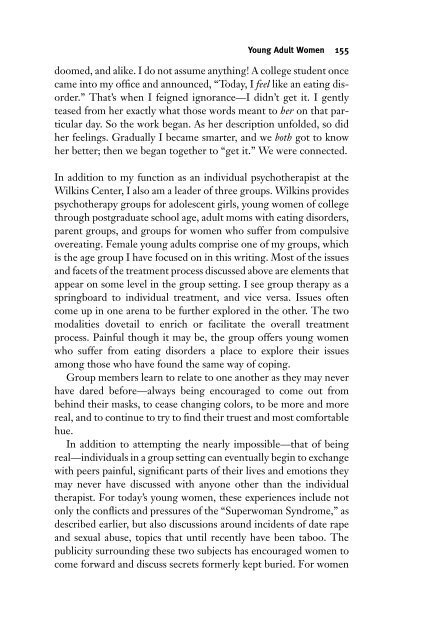Eating Disorders - fieldi
Eating Disorders - fieldi
Eating Disorders - fieldi
Create successful ePaper yourself
Turn your PDF publications into a flip-book with our unique Google optimized e-Paper software.
Young Adult Women 155<br />
doomed, and alike. I do not assume anything! A college student once<br />
came into my office and announced, “Today, I feel like an eating disorder.”<br />
That’s when I feigned ignorance—I didn’t get it. I gently<br />
teased from her exactly what those words meant to her on that particular<br />
day. So the work began. As her description unfolded, so did<br />
her feelings. Gradually I became smarter, and we both got to know<br />
her better; then we began together to “get it.” We were connected.<br />
In addition to my function as an individual psychotherapist at the<br />
Wilkins Center, I also am a leader of three groups. Wilkins provides<br />
psychotherapy groups for adolescent girls, young women of college<br />
through postgraduate school age, adult moms with eating disorders,<br />
parent groups, and groups for women who suffer from compulsive<br />
overeating. Female young adults comprise one of my groups, which<br />
is the age group I have focused on in this writing. Most of the issues<br />
and facets of the treatment process discussed above are elements that<br />
appear on some level in the group setting. I see group therapy as a<br />
springboard to individual treatment, and vice versa. Issues often<br />
come up in one arena to be further explored in the other. The two<br />
modalities dovetail to enrich or facilitate the overall treatment<br />
process. Painful though it may be, the group offers young women<br />
who suffer from eating disorders a place to explore their issues<br />
among those who have found the same way of coping.<br />
Group members learn to relate to one another as they may never<br />
have dared before—always being encouraged to come out from<br />
behind their masks, to cease changing colors, to be more and more<br />
real, and to continue to try to find their truest and most comfortable<br />
hue.<br />
In addition to attempting the nearly impossible—that of being<br />
real—individuals in a group setting can eventually begin to exchange<br />
with peers painful, significant parts of their lives and emotions they<br />
may never have discussed with anyone other than the individual<br />
therapist. For today’s young women, these experiences include not<br />
only the conflicts and pressures of the “Superwoman Syndrome,” as<br />
described earlier, but also discussions around incidents of date rape<br />
and sexual abuse, topics that until recently have been taboo. The<br />
publicity surrounding these two subjects has encouraged women to<br />
come forward and discuss secrets formerly kept buried. For women









